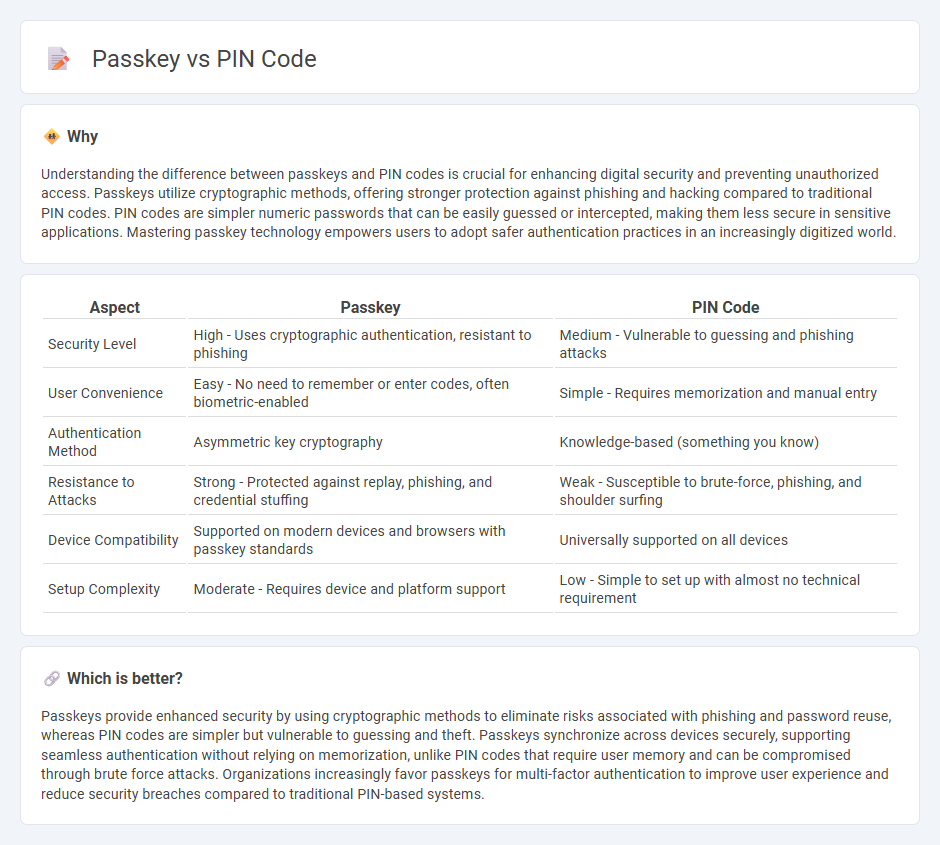
Passkeys offer enhanced security by using cryptographic keys instead of traditional PIN codes, reducing the risk of phishing and unauthorized access. Unlike PINs, which can be guessed or intercepted, passkeys rely on biometric or device-based authentication methods that are unique and difficult to replicate. Explore the differences between passkeys and PIN codes to better protect your digital identity.
Why it is important
Understanding the difference between passkeys and PIN codes is crucial for enhancing digital security and preventing unauthorized access. Passkeys utilize cryptographic methods, offering stronger protection against phishing and hacking compared to traditional PIN codes. PIN codes are simpler numeric passwords that can be easily guessed or intercepted, making them less secure in sensitive applications. Mastering passkey technology empowers users to adopt safer authentication practices in an increasingly digitized world.
Comparison Table
| Aspect | Passkey | PIN Code |
|---|---|---|
| Security Level | High - Uses cryptographic authentication, resistant to phishing | Medium - Vulnerable to guessing and phishing attacks |
| User Convenience | Easy - No need to remember or enter codes, often biometric-enabled | Simple - Requires memorization and manual entry |
| Authentication Method | Asymmetric key cryptography | Knowledge-based (something you know) |
| Resistance to Attacks | Strong - Protected against replay, phishing, and credential stuffing | Weak - Susceptible to brute-force, phishing, and shoulder surfing |
| Device Compatibility | Supported on modern devices and browsers with passkey standards | Universally supported on all devices |
| Setup Complexity | Moderate - Requires device and platform support | Low - Simple to set up with almost no technical requirement |
Which is better?
Passkeys provide enhanced security by using cryptographic methods to eliminate risks associated with phishing and password reuse, whereas PIN codes are simpler but vulnerable to guessing and theft. Passkeys synchronize across devices securely, supporting seamless authentication without relying on memorization, unlike PIN codes that require user memory and can be compromised through brute force attacks. Organizations increasingly favor passkeys for multi-factor authentication to improve user experience and reduce security breaches compared to traditional PIN-based systems.
Connection
Passkeys and PIN codes both serve as authentication methods to enhance security by verifying user identity. Passkeys use cryptographic key pairs for passwordless login, while PIN codes provide a simple numeric password stored securely on a device. Their connection lies in combining biometric or cryptographic passkeys with PIN codes to create multi-factor authentication, improving protection against unauthorized access.
Key Terms
Authentication
A PIN code is a numeric password commonly used for device access and authentication due to its simplicity and speed, whereas a passkey leverages cryptographic protocols to provide stronger, phishing-resistant authentication across multiple platforms. Passkeys eliminate the need to remember complex passwords by utilizing biometric data or secure device credentials, enhancing security in digital authentication processes. Explore how integrating passkeys can elevate your security framework beyond traditional PIN-based methods.
Security
PIN codes provide basic security by requiring a numeric code for access, but they are vulnerable to brute force attacks and shoulder surfing. Passkeys use cryptographic methods for authentication, offering stronger protection against phishing and unauthorized access. Discover how passkeys enhance security beyond traditional PIN codes by exploring the latest authentication technologies.
Access Control
PIN code is a numeric or alphanumeric sequence used primarily for user authentication in access control systems, offering a fast and straightforward way to verify identity. Passkeys, often involving biometric data or cryptographic keys, provide enhanced security by leveraging unique user attributes or devices, reducing the risk of unauthorized access. Explore the differences in security levels and usability between PIN codes and passkeys to optimize your access control strategy.
Source and External Links
Personal identification number - A numeric (sometimes alpha-numeric) passcode used to authenticate a user accessing a system, commonly in banking, secure access, and online transactions.
Postal Index Number - A six-digit code in the Indian postal system that helps sort and deliver mail efficiently across the country.
Get an Identity Protection PIN (IP PIN) - A six-digit number issued by the IRS to prevent tax-related identity theft by verifying the taxpayer's identity when filing a return.
 dowidth.com
dowidth.com